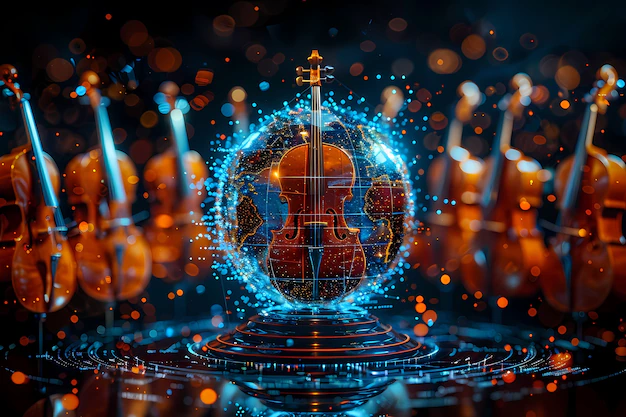Music and technology have always shared a symbiotic relationship, advancing together to create new tools for expression and innovation. Among the latest breakthroughs is harmonicode—a revolutionary concept that bridges traditional music theory with digital technology. But what exactly is harmonicode, and why is it generating so much buzz in the music and tech communities?
This blog explores harmonicode origins, functionality, and the benefits it offers to musicians, educators, and learners alike. By the end, you’ll have a clear understanding of why harmonicode is poised to change how we interact with music in the digital age.
The Origins of Harmonicode
Harmonicode did not emerge in a vacuum; it’s the product of decades of innovation at the intersection of music theory and technology.
A Historical Perspective
The foundation of harmonicode lies in the principles of traditional music theory. Composers like Bach, Mozart, and Beethoven were effectively ‘coding’ patterns of harmony, tempo, and rhythm into their compositions. This concept of pre-defined structures in music served as a precursor to harmonicode.
Fast forward to the digital era, where advances in computer algorithms and artificial intelligence presented opportunities to reimagine music creation. Engineers and theorists began merging algorithms with harmonic principles, giving rise to systems capable of replicating, analysing, and even innovating on musical compositions. Harmonicode was born—a system that translates the complex language of music into code for a variety of practical applications.
Innovation at the Core
What makes harmonicode truly groundbreaking is its ability to deconstruct and reconstruct music into a coded language that is both interpretable by humans and executable by machines. Unlike standard MIDI systems that focus on notes and channels, harmonicode takes into account the intricate relationships between different elements of music, ensuring a level of detail and cohesion previously unattainable.
Understanding Harmonicode
Now that we know where harmonicode originates from, let’s unpack how it works and its practical applications.
The Fundamentals
At its core, harmonicode is a set of algorithms that encode harmonic relationships within a piece of music. It analyses elements like melody, harmony, rhythm, and dynamics, translating them into a digital language. This ‘code’ can then be manipulated or utilised in numerous ways, such as generating new compositions, improving music production workflows, or serving as an instructional tool.
For example:
- Encoding: Harmonicode takes an existing musical piece and breaks it down into a mathematical model based on harmonic relationships.
- Generating: Once encoded, the software can create new compositions that adhere to similar harmonic principles, ensuring they are aesthetically pleasing and cohesive.
- Analysing: Harmonicode can analyse compositions to detect potential issues, making it invaluable for music professionals.
Real-World Applications
Harmonicode isn’t just a theoretical concept—it’s being used in real-world scenarios to drive innovation:
- Music Composition: Musicians can use tools powered by harmonicode algorithms to generate chord progressions, melodies, and even entire arrangements at the click of a button.
- Educational Tools: Music educators leverage harmonicode to teach complex theoretical concepts more effectively, offering a hands-on approach to learning harmony.
- Film Scoring: Film composers can employ harmonicode to experiment with harmonies and create mood-specific soundtracks.
- Accessibility: Aspiring musicians without formal training can use harmonicode-powered applications to start creating music without needing in-depth theoretical knowledge.
The Benefits of Harmonicode
From transforming workflows to making music accessible to a wider audience, harmonicode brings numerous benefits.
For Musicians
Harmonicode simplifies the creative process for musicians. Whether you’re a seasoned composer or a hobbyist, harmonicode allows you to explore harmonic possibilities quickly and easily. By automating repetitive tasks like harmonising or creating chord progressions, musicians can focus more on creativity.
For Educators and Students
Music theory can often be intimidating to learners. Harmonicode bridges this gap by providing visual and interactive tools that make learning harmony engaging and intuitive. Students can see how harmonic relationships play out in real-time, while educators gain a powerful resource for visualising complex concepts.
Enhancing Inclusivity and Accessibility
One of harmonicode’s greatest achievements is making music creation more accessible to individuals without formal training or those with disabilities. With intuitive tools that guide the composition process, harmonicode’s empowers diverse groups to participate in music creation in ways that weren’t possible before.
Harmonicode’s and SEO: A Unique Digital Opportunity
Beyond its application in music, harmonicode’s holds great potential for creating SEO-friendly content.
Optimising Harmonicode’s Content
For businesses or creators producing content about harmonicode’s following these SEO strategies is key:
- Keyword Integration: Use relevant keywords such as ‘harmonicode’s tools’, ‘music theory coding’, and ‘AI music technology’ in headings, meta-descriptions, and body text.
- High-Quality Backlinks: Link to authoritative sources on music and technology to enhance content credibility.
- Engaging Visuals: Incorporate diagrams or videos to explain how harmonicode’s works—search engines favour multimedia content.
Capturing Search Interest
The interest in AI-driven music tools is growing, making harmonicode’s an ideal topic for blogs, tutorials, and webinars. Capturing this search interest can drive significant traffic to websites offering insights or products related to harmonicode’s.
Harmonicode’s Bright Future
Harmonicode’s represents a bold step forward in the fusion of music and technology. By decoding one of the most complex forms of human expression into an understandable and interactive format, harmonicode’s has opened up a world of possibilities for creators, educators, and learners. Its applications in accessibility and inclusivity further position it as a tool with the potential to democratise music-making for all.
Whether you’re a musician looking to innovate, a teacher seeking to engage students, or simply curious about the future of music technology, harmonicode’s is worth exploring.

